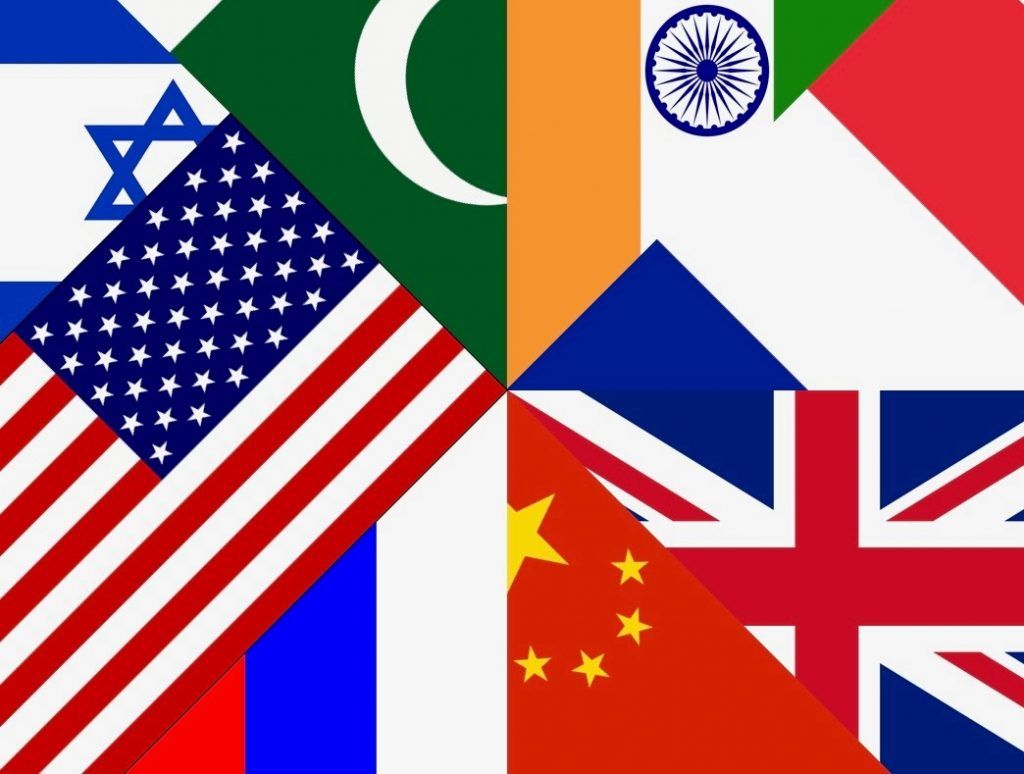A not so modest proposal: Maintain the INF, extend New START, and involve new actors in arms control
By Pierce S. Corden | June 26, 2019
 The flags of states that could be part of new arms control negotiations. United States, Russian Federation, China, United Kingdom, France, India, Pakistan and Israel.
The flags of states that could be part of new arms control negotiations. United States, Russian Federation, China, United Kingdom, France, India, Pakistan and Israel.
For the United States and the Russian Federation to avoid withdrawal from the Intermediate-range Nuclear Forces Treaty on August 2, 2019, both parties must resolve claims that the other is in noncompliance. The Treaty prohibits deployment of missiles with a range between 500 and 5500 kilometers and their launchers. The United States cites intelligence that the Russian Federation tested a cruise missile within the prohibited range, and has deployed several battalions of these missiles. Russia takes issue with the US ballistic missile defense system, Aegis Ashore, as being capable of launching INF-range cruise missiles. Aegis Ashore systems are currently deployed in Romania and are headed to Poland.
The back and forth accusations of INF Treaty violations are not new. The United States has accused the Russian Federation of violating the agreement, first by its testing and now by deployment. These accusations were met with denials, requests for details, and counter-accusations. When the United States identified which cruise missile they judged was in violation, Russia offered to display the 9M729 cruise missile to US inspectors but, bilateral discussions earlier this year failed to resolve the situation.
President Trump is now exploring the possibility of addressing the INF issue by reframing how the practice of arms control is conducted. Instead of focusing on bilateral agreements between the United States and the Russian Federation (the two countries with the largest nuclear arsenals) the President believes that we should involve more actors. Actors like China who also have deployed missiles with INF range.
A path forward might begin with Presidents Trump and Putin suspending the August 2 withdrawal and pursuing discussions to agree to on-site inspections of both the 9M729 cruise missile and the Aegis Ashore installations. Russia would need to demonstrate that the range of the missile was less than 500 km; US intelligence suggests previous tests of the 9M729 cruise missile exceeded 500 km. If the missile as deployed is found to be in violation, it would need to be modified in a verifiable manner to ensure that its range is less than 500 km. This would probably involve modification to its fuel capacity. For the Aegis Ashore system, it will likely be necessary to modify these installations until the Russians are satisfied that they comply with the INF Treaty.
Assuming that the INF Treaty can be sustained and anticipating that the New START limits on nuclear arsenals are extended, the United States and Russian Federation would be in a position to propose an agreement involving China and potentially the UK, France, India, Pakistan, and Israel. This new agreement would aim to engage the other nuclear-armed states, including those not party to the Non-Proliferation Treaty, and put limits on their nuclear-weapon systems. The objective would be a declared ceiling on the systems of each participating state.
Both the United States and the Russian Federation would need to set overall ceilings on their nuclear weapons to complement the INF and New START undertakings. China would need to agree to announce a ceiling on its deployed systems (perhaps beginning with the launchers), as would India and Pakistan. The United Kingdom and France have fairly well known upper bounds on the numbers of their deployed warheads. Israel would be more complicated because it does not officially acknowledge possessing nuclear weapons. Language could be devised preserving its ambiguous position, e.g., “Israel states that it will not be the first state to introduce nuclear weapons into the Middle East, and in no case would this number exceed X.” States need not all join into the agreement at the same time. As with the early US-USSR SALT agreements, verification of the ceilings would be by national technical means. Hopefully, as such an undertaking was negotiated, North Korea would agree to return to the NPT as a non-nuclear-weapon state, with its relevant nuclear materials under IAEA safeguards.
These established ceilings would provide a basis for further reductions over time, bearing in mind the large differences in numbers and/or announced ceilings on numbers among the states involved and thus be an important next step toward the global elimination of nuclear weapons.
Together, we make the world safer.
The Bulletin elevates expert voices above the noise. But as an independent nonprofit organization, our operations depend on the support of readers like you. Help us continue to deliver quality journalism that holds leaders accountable. Your support of our work at any level is important. In return, we promise our coverage will be understandable, influential, vigilant, solution-oriented, and fair-minded. Together we can make a difference.
Keywords: INF Treaty, New START, arms control, nuclear risk
Topics: Nuclear Risk, Nuclear Weapons, Opinion














